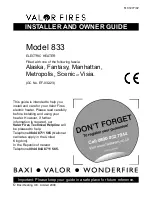
CONQUEST
®
WATER HEATER
18
PV500-71 02/16
6.7 Gas Connection
1. Safe operation of unit requires adequate gas supply with the required static and dynamic (flow) pressures. Actual
piping selection depends on many variables that must be carefully considered by the gas piping system designer.
2. Do not select gas pipe sizes based only on the supplied tables. These tables are for use by the gas piping
system designer as a reference in checking pipe size selections.
3. Gas pipe size may be larger than heater connection.
4. Installation of a union is suggested for ease of service.
5. Install a manual main gas shutoff valve on the gas supply piping connected to the appliance to isolate the burner
and gas train from the main supply gas in compliance with NFPA 54 National Fuel Gas Code and most local
Codes.
6. The gas system installer must clearly identify the emergency shut-off device.
7. A sediment trap (drip leg) MUST be provided in the inlet of the gas connection to the unit.
8. Conquest models 50 - 80 combination gas valves and/or gas regulators incorporate either an internal vent limiter
or an externally mounted vent limiting orifice and 1/4" aluminum tube located in a “T” attached to the regulator
vent port. Venting to outdoors is not required. Never remove, cut, splice or alter the flexible tubing attached
directly to the regulator vent port or to a vent limiting fitting attached externally to the regulator, as this will cause
unreliable ignition and can cause improper operation. Although not required, a connection to the open end of the
1/4" aluminum tube can be made and routed to the outdoors. No other connection point is allowed. Do not
remove the aluminum tubing and connect directly to the “T”, as damage to the required vent limiter and improper
gas control could result.
9. Conquest model 40 combination gas valve contains an internal venter. Venting to outdoors is not allowed.
7.
COMBUSTION AND VENTILATION AIR
Provisions for adequate combustion and ventilation air to the mechanical room must be in accordance with Section
“Air for Combustion and Ventilation” in the latest edition of the NFPA 54 National Fuel Gas Code, ANSI Z223.1
and/or CAN/CSA B149, Installation Codes or applicable provisions of the local building codes. Any method
addressed in NFPA 54 National Fuel Gas Code section “Air for Combustion and Ventilation is acceptable and
several are outlined below.
7.1 Equipment Located In Confined Spaces
Equipment located in confined spaces requires two openings, one commencing within 12" (30.5 cm) from the top of
the enclosure/room and one commencing within 12" from bottom of the enclosure/room to assure adequate
combustion air and proper ventilation. The total input of all gas utilization equipment installed in the room must be
used to determine the required minimum air volume needed for combustion, ventilation and dilution of flue gasses.
Also consider makeup air requirements from other equipment within the mechanical room or other rooms that are
pressure connected with the mechanical room. Some examples of other makeup air requirements are from kitchen
exhaust hoods, clothes dryers, powered exhaust fans, etc.
•
All Air From Outdoors:
Each opening requires a minimum free area of 1 square inch
per 4000 Btu/hr of the total input rating of all
appliances in the enclosure, if directly communicating with the outdoors or communicating to the outdoors
through vertical ducts.
Each opening requires a minimum free area of 1 square inch
per 2000 Btu/hr of the total input rating of all
appliances in the enclosure, if communicating with the outdoors through horizontal ducts.
•
All Air From Inside The Building:
Follow the requirements of NFPA 54 National Fuel Gas Code, ANSI Z223.1 section “Indoor Combustion Air.”
•
Combination Of Air From The Indoors And From The Outdoors:
Follow the requirements of NFPA National Fuel Gas Code, ANSI Z223.1 section “Combination Indoor and
Outdoor Combustion Air.”
•
From Outdoors Through One Opening:
Follow the requirements of NFPA National Fuel Gas Code, ANSI Z223.1 section “One Permanent Opening
Method.”
















































